It’s just me in my madder stained gloves ![]()

A favorite print from today…the basics. Eucalyptus on Wool.
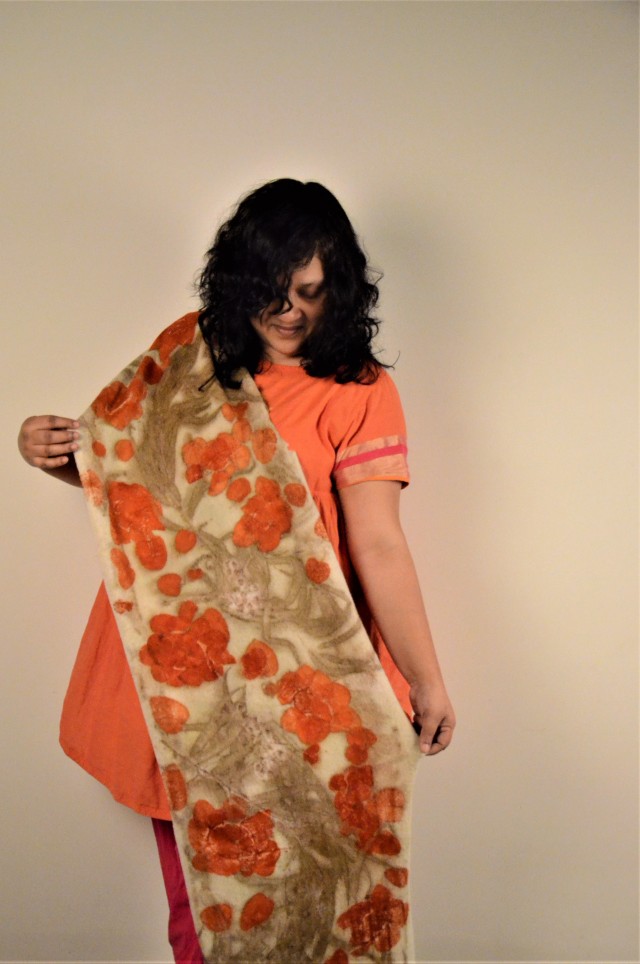
Look what is going straight into the dye pot this weekend! Buckthorn leaves from Belgium. 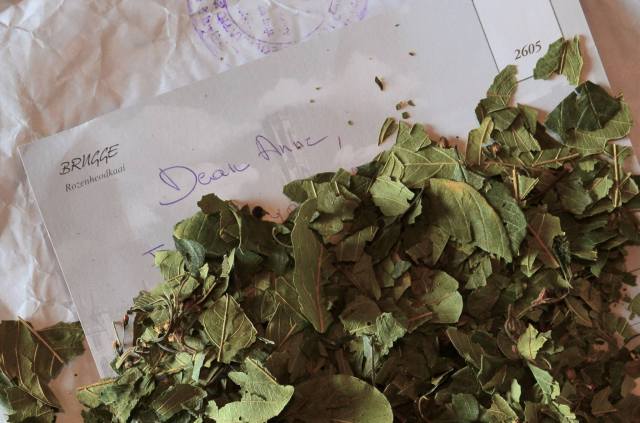
Heavy rains in Bangalore has brought down many tall trees. I brought home some leaves from a eucalyptus that had fallen on to the road near Lalbagh Botanical Gardens. Appa was my helper today ![]() 😘
😘


3 young teak leaves send their love ![]()
![]()
Meringue Silk left in henna bath for 3 days. Leaves soaked in coconut vinegar bath, bundled and steamed for 2 hours. A cotton blanket soaked in coconut vinegar bath brought out that delicious mocha milk background color.
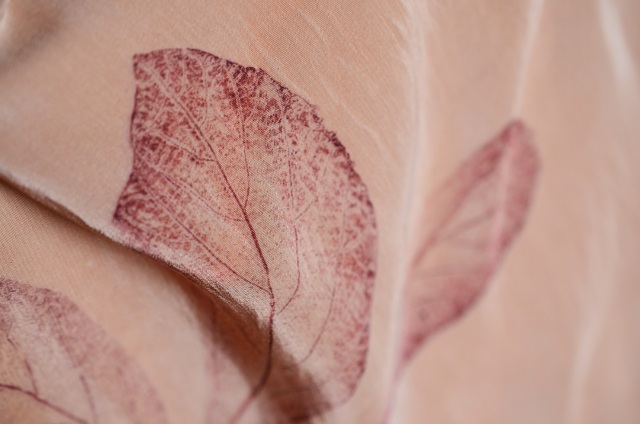
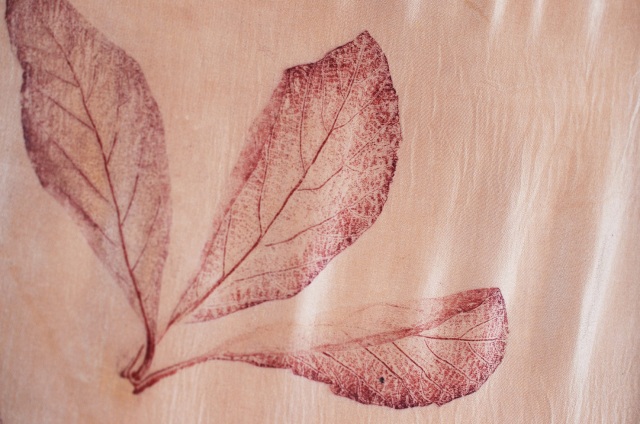
A piece of Nubuck Silk and a piece of felted Leh Wool knit….bundled with Euca leaves and buds…slowly, I am beginning to practice my lessons in ecoprint from my guru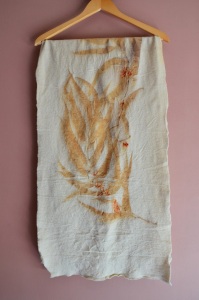
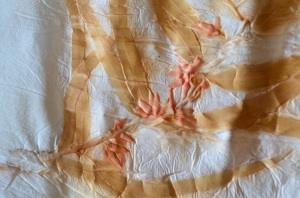 Irit Dulman.
Irit Dulman.
 Alkanet (Alkanna tinctoria) is a plant of the Borage family and is also known as Batschia Canescens and Dyer’s Bugloss. It is a flowering plant and produces blue flowers. However, it is the roots that contains Alkannin, the dye we are interested in. The red coloring extracted from the roots have been in use since ancient times as a colorant for food, wines, tinctures, varnishes etc.
Alkanet (Alkanna tinctoria) is a plant of the Borage family and is also known as Batschia Canescens and Dyer’s Bugloss. It is a flowering plant and produces blue flowers. However, it is the roots that contains Alkannin, the dye we are interested in. The red coloring extracted from the roots have been in use since ancient times as a colorant for food, wines, tinctures, varnishes etc.
Alkannin can be extracted into alcohol or oil, as it is not soluble in water. When steeped in oil for about 4-6 weeks, Alkanet root releases a deep crimson color.
In natural dye baths, use Alkanet at 75%-100% to dry weight of fiber. Colors achieved on natural fibers are lavender, purple and grey. To get best results, apply moderate heat to the dye bath, keeping it below 60°C / 140°F.
In soap making, colors achieved are lavender, purple, grey, depending on the pH of the soap mixture. For best results, substitute part of the oil in your soap recipe with Alkanet oil extract.
Alkanet oil extract can also be used as a wood stain to impart deep red hues similar to rosewoods.
Alkanet extract is also used as a food color
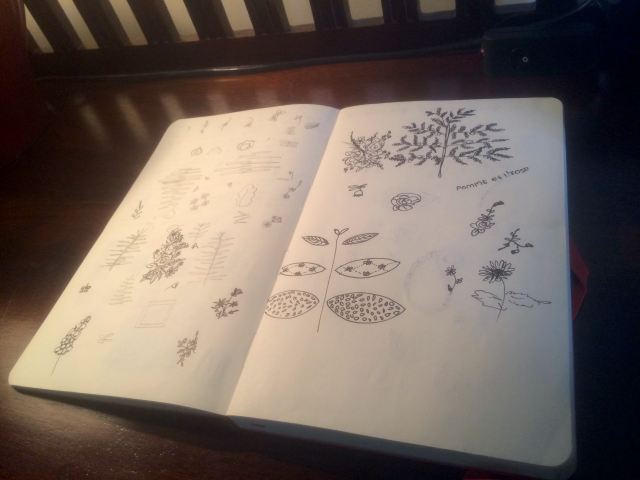 Little journals have been a part of my life’s journey for a long time now. They hold my scribblings, caricatures, folk art, quotes, thoughts and poems and just about anything I pick up from here and there… This page here is from a rainy afternoon in 2013… A new collection of prints had been playing in my mind and it just wouldn’t come together. So there I was, staring at these 2 pages of doodles and many others, hoping for that moment of epiphany….
Little journals have been a part of my life’s journey for a long time now. They hold my scribblings, caricatures, folk art, quotes, thoughts and poems and just about anything I pick up from here and there… This page here is from a rainy afternoon in 2013… A new collection of prints had been playing in my mind and it just wouldn’t come together. So there I was, staring at these 2 pages of doodles and many others, hoping for that moment of epiphany….
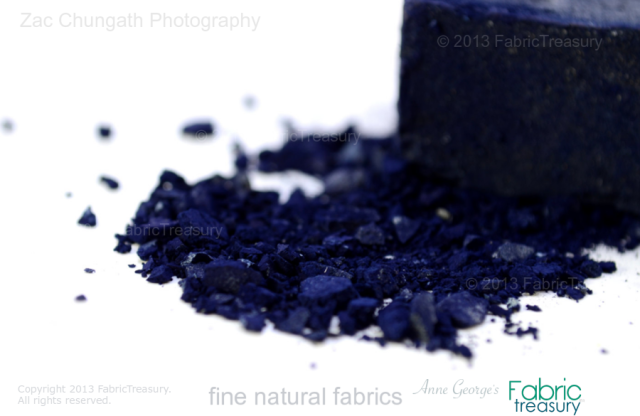 INDIGO – The color of ancients. Photographed by Zac Chungath
INDIGO – The color of ancients. Photographed by Zac Chungath
Indigo is an ancient dye and can be traced back to as far as 5000 BC. It is an integral part of the dyeing traditions in India, which is believed to be the oldest center of indigo cultivation in the Old World. It was a primary supplier of indigo to Europe as early as the Greco-Roman era. The association of India with indigo is reflected in the Greek word for the dye, indikón (ινδικόν, Indian). The Romans latinized the term to indicum, which passed into Italian dialect and eventually into English as the word indigo. During the colonial times, British established a monopoly on the cultivation and trade of Indigo. It was one of the most profitable commodities of the East India Company, so valuable that it was referred to as Blue Gold. Other European countries had no access to Indigo from India and to resolve this rather peculiar problem, they set about to experiment ways in which to manufacture Indigo in laboratories. Several years and 18 milion franks later, a German company named BASF succeeded in the manufacture of synthetic Indigo.
Since the invention of synthetic Indigo, world gradually moved away from natural indigo and thereby cultivation and use of natural Indigo fell back into tiny pockets of the world where traditional textile dyeing practices persisted. As we become aware of environmental hazards caused by synthetic dyes, we are turning back more and more into natural dyeing practices. A renewed interest of the dyes of the ancient is noted now.
Indigo (nil) naturally occurring dye stuff obtained from various plants, particularly those of genus Indigofera. They are found to grow wild in India, Central America and China. Indigo is also present in the juices of Isatis tinctoria or woad plant cultivated in Britain. The natural Indigo dye stuff available at Fabric Treasury is from Indigo plantations of South India, and is available in both the cake and powder form.
Indigo dyeing is a multi step process, depending on the color shade of blue one hopes to achieve. Once mastered, indigo dyeing can be done at home, within minimal environmental impact. This is the best dye to achieve amazing hues of natural blues which has a way of capturing the eye.
Summer is beating down with a vengeance and I squirreled away some of the Summer Ice linen fabrics for my summer dress projects. So I made dresses in 2 colors – pink and blue. Styled to fall slightly away from the body, these 2 dresses are turning to be my favorites. Now, those of you all who know me will remember that when I find a pattern I am comfortable in, you will be seeing more of the same style on me. Much to the annoyance of mumsey, she is not particularly fond of my obsession with making one too many dresses in the same pattern. She loves this style though. Oh well, for me, if something feels good on me, why bother chasing down change just for the sake of it, eh?
Summer Ice Linen is handwoven with 100 Lea belgian linen in a 90 x 90 weave. This fabric is as light as air and has a faint nubbiness about it. Perfect feel for hot summer days.
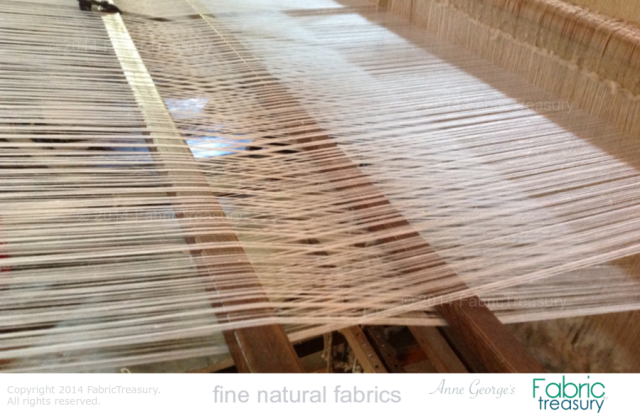
Summer Ice on the loom. Handwoven by masters on vintage looms.
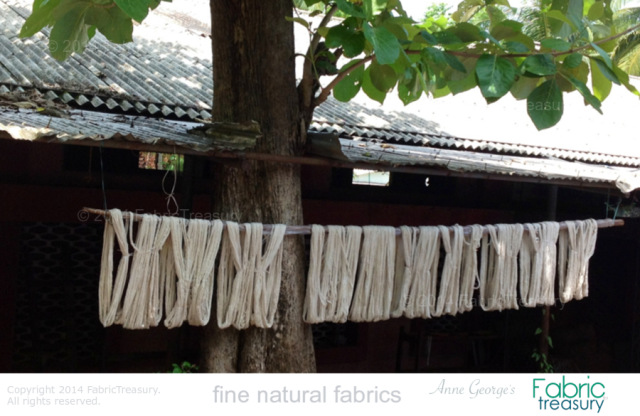
Yarn for Summer Ice Linen collection. Bleached and hung to dry before they go into dye pots.
Summer Ice collection is now featured at FabricTreasury.
Welcome to your new home on WordPress.com
Travel and capsule wardrobe inspiration for the garment sewist.
A film series and discussion forum dedicated to the science and practice of natural dyes and pigments using sustainable methods.
Enjoy the simple things in life...
Sewing classic fashions from mid-century patterns
Bipolar. DIY Enthusiast. Migraine Warrior, Christian. Coffee addict. Spoonie
creating and shaping wellbeing, celebrating and commemorating life
Waldorf Homeschooling and Life
A colorful harvest
(because the world needs more meatbagz)
Beauty, Fashion, Life: You
Shop the Best for Less